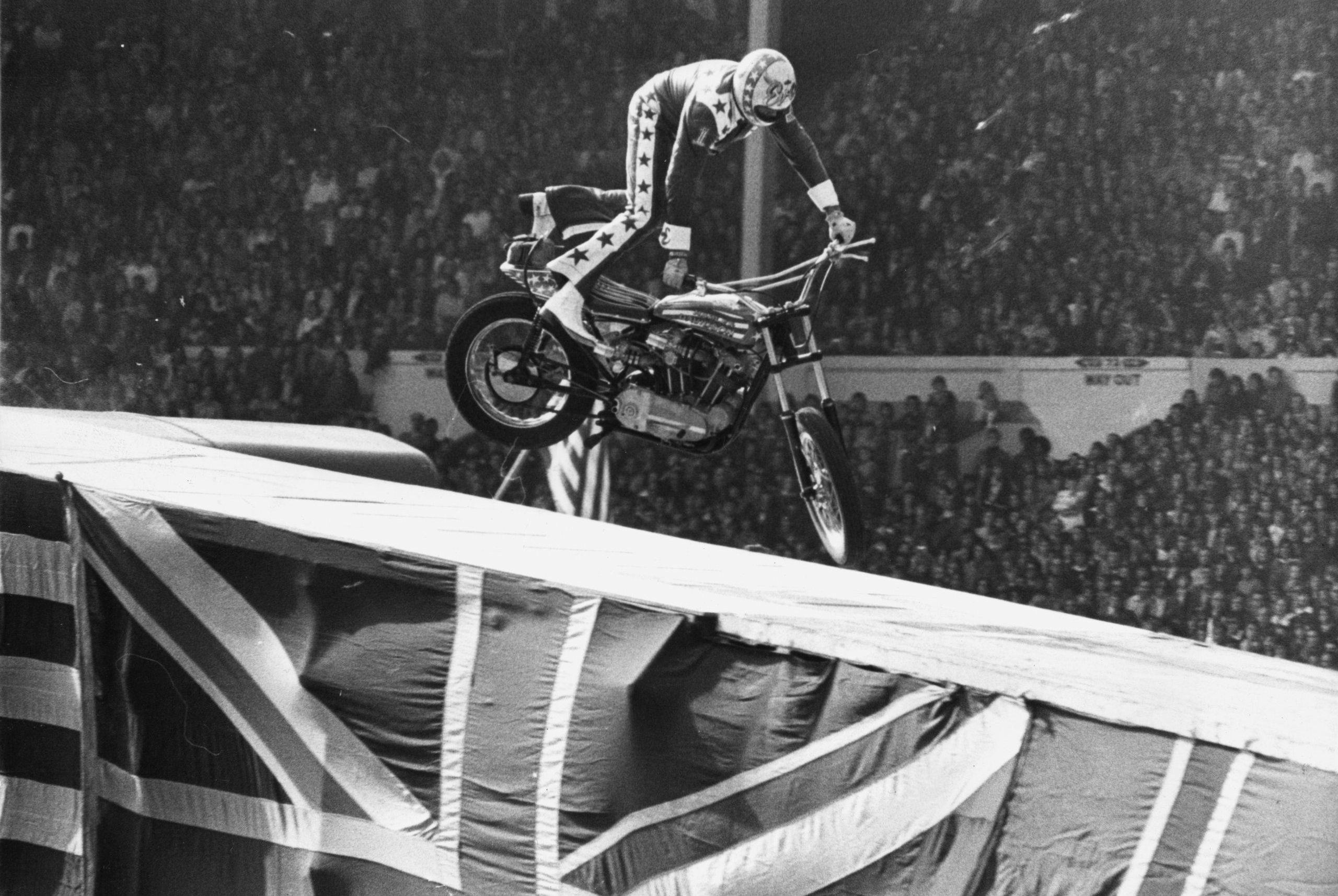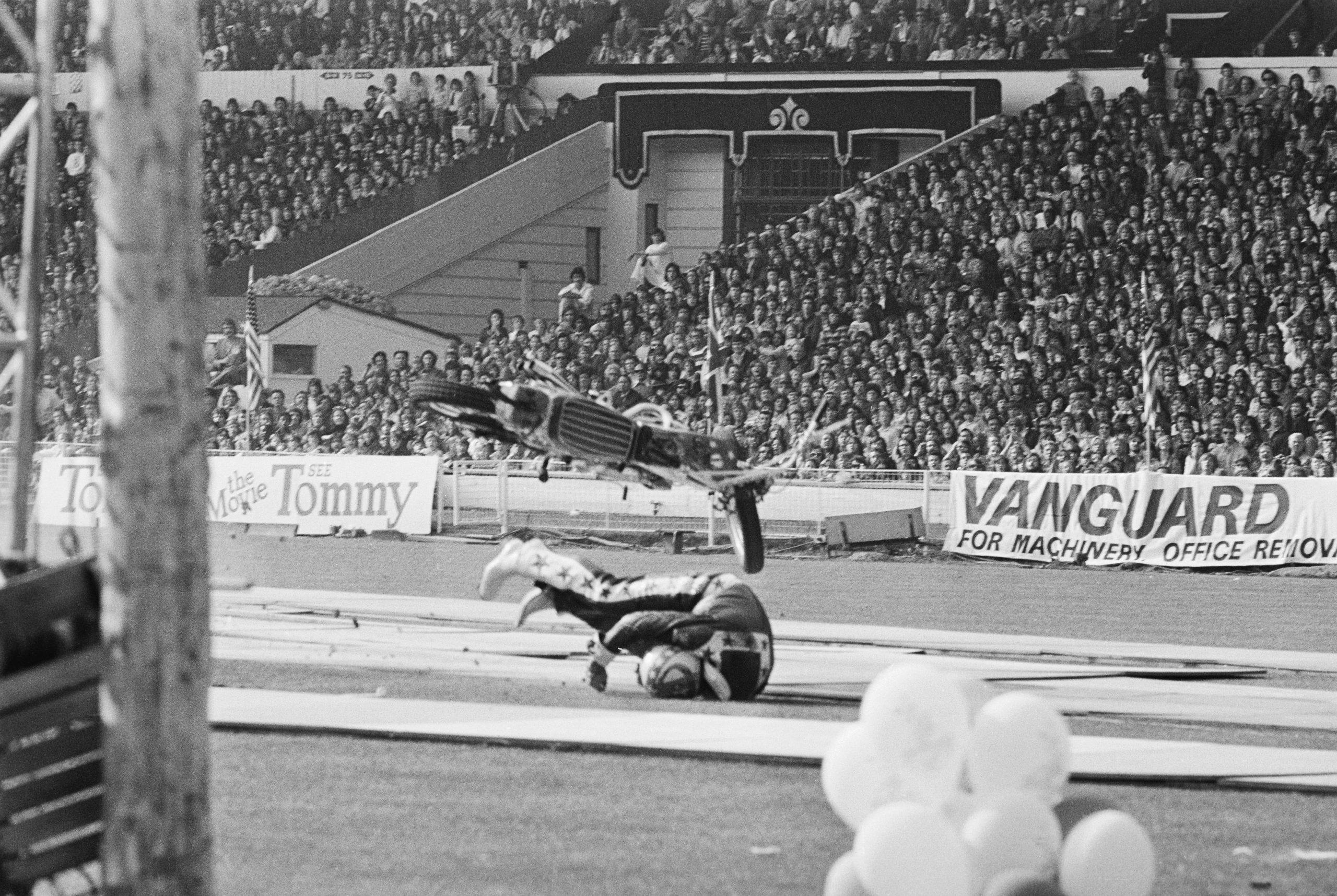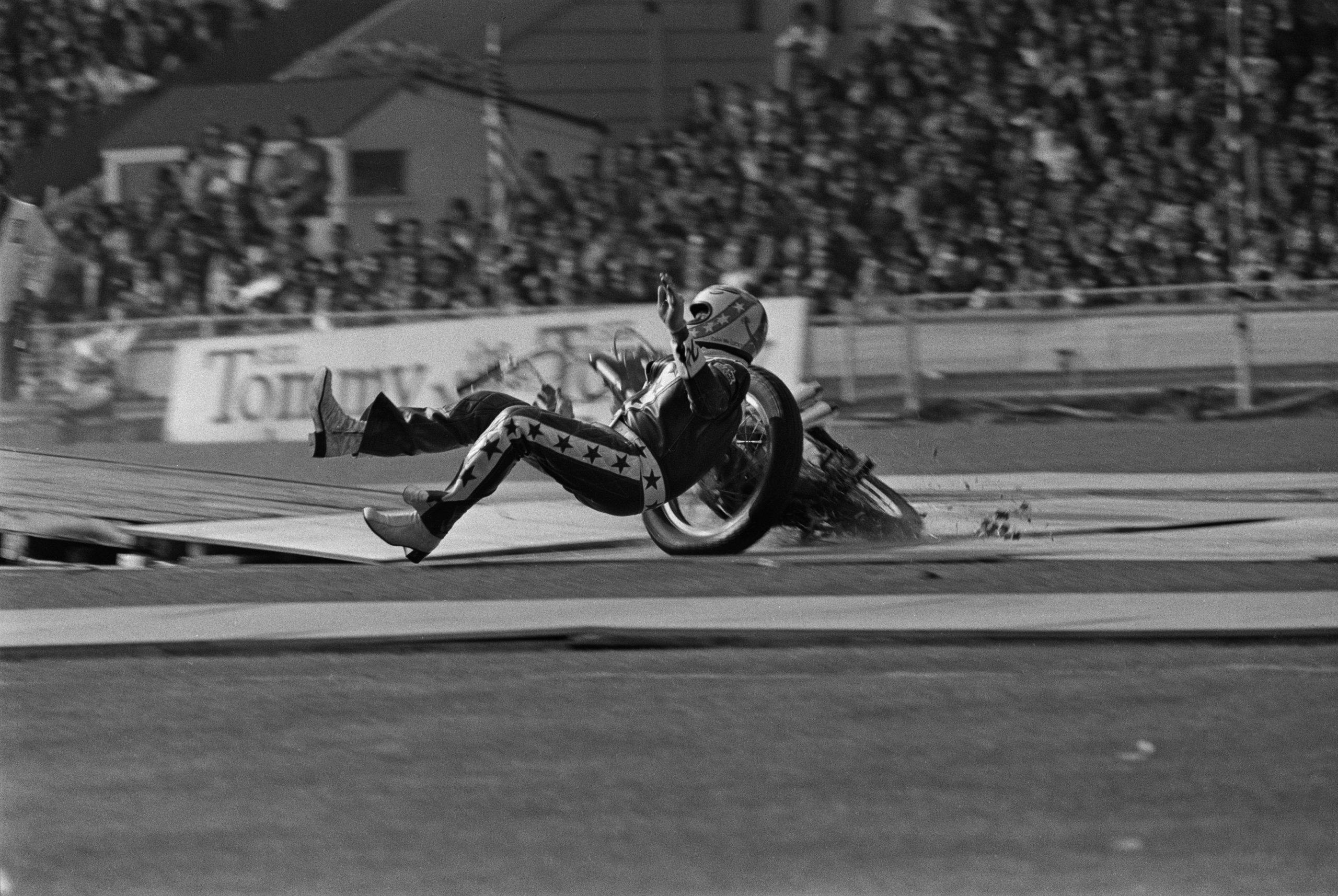Evel Empire: Knievel’s stranglehold on the Seventies
Evel Knievel had a stock answer for reporters when they asked him: Well … why? “There’s three mysteries to life,” he said, with practiced conviction. “Where we came from, why we do what we do, and where we’re going to go. You don’t know the answer to any of those three, and neither do I.” Standing next to the Snake River Canyon in Idaho in 1974, as crew members prepped his water-powered rocket cycle to fly the chasm in what would be his ballsiest cheat of death yet, he added: “I’m going to jump it to get to the other side, and I don’t want to drive across that damn bridge.”
A half a century later, we know some of the answers to the three mysteries of Knievel, including where he came from and where he went. We may never really know why, but he probably gave us his best clue in Idaho: “I don’t want to drive across that damn bridge.” Like everyone else would, like mere mortals would. Wherever Evel Knievel would go in life, he planned to fly.
Since Snake River, many of Knievel’s motorcycle jumping records have been toppled with ease. Lighter bikes, miles of suspension travel, and broad dirt ramps have produced YouTube spectacles that are both thrilling and safer. But no one has done it with the showmanship or command of hyperbole that captivated 1970s Malaise-Era America. Knievel in the white star-spangled suit never quite showed all of his cards—but then again, he never really had any, refusing to use a speedometer, a tachometer, or any pre-jump calculations. It was all gut. He ripped shots of Wild Turkey hidden in his diamond cane and then set sail, arcing through the air like a comic book superhero while straddling America’s number one escape vehicle.
His star turns on color TV as well as the 1971 film, Evel Knievel, produced so many iterations of half-truths and exaggerations about his life that it’s hard to separate fact from fiction, and that’s just fine. The film catalyzed the daredevil emperor’s conquest and spun him into a national phenomenon with intense command over the social spotlight. Such command, in fact, that even 50 years after the film’s release, we still remember him.

The Lord almighty gifted Robert Craig Knievel to the world on October 17, 1938, in Butte, Montana. Once called “The Richest Hill on Earth” for its position atop veins of copper, silver, and gold, Butte in the 1940s and ’50s was a jagged place. Shafts bored the landscape into Swiss cheese. Big machines, big money, big egos. The youngster with the German last name, pronounced Kin-evil, was a handful, his natural recklessness stoked by the rough-and-tumble mining town. At 18, he wound up in jail—it wasn’t the first time, nor the last—after evading the police but ultimately crashing his getaway motorcycle. There he shared cell walls with a William Knofel, and prison guards labeled the convicts “Awful” Knofel and “Evil” Knievel. The name stuck, but Knievel changed the “i” to an “e” because, despite his misconduct, he didn’t want to be considered evil. He eventually slipped the bars and joined the Army, but his service didn’t last long, and the dropout returned to Butte, where he landed a job at the copper mine. He was promoted to surface duty, but soon he was fired for pulling a wheelie with the bulldozer and knocking over Butte’s main power line.
He was an adrenaline junkie before the term existed. To feed his habit, he dabbled in skiing, rodeo riding, and motorcycle racing. At 19, Knievel formed his own semi-pro hockey team, the Butte Bombers, then somehow persuaded the Czechoslovakian national team to play an exhibition—in Butte, no less. The Czechs destroyed the Bombers, 22 to 3, while Knievel passed a plate around, urging spectators to defray the Czechs’ travel expenses. After the final buzzer, everyone was shocked to find the money gone, along with Knievel.
During those formative years, he also burglarized businesses from Montana to Oregon. In a 1971 interview with The New Yorker, he confessed his sins. “When I was stealing, I’d go into a store and ask if they had fire-and-theft, pretend I was selling insurance,” he said. “If the man in the store said he already had insurance and if his attitude was bad—if he told me to get the hell out—then I’d go back that night and rob him. I never carried a gun, never hurt anybody except the insurance companies, and they’re bastardly thieves anyway.” (Knievel spent a few years of his life as a legitimate insurance salesman.) Soon enough, the law closed in. “I had a terrible breakdown when I was about 25. The police chased me across four states—I was in a Pontiac Bonneville, going 120 miles an hour, and after that, I just couldn’t stand the pressure.” So he gave up the life of crime.
Why we do what we do. It was 1966, and after some brief stints selling insurance and Honda motorcycles, Knievel stepped into the sideshow stunt world of county fairs and other regional events. His father had taken him to see the Joie Chitwood Thrill Show, an automotive circus featuring cars jumping, cars on two wheels, and cars on fire. In Washington, Knievel decided to start his own stunt brigade on motorcycles. He partnered with a Norton distributor, dressed in bumblebee-colored leathers, and briefly reinstated the “i” in his stage name. “Evil Knievel and His Motorcycle Daredevils!” Their first show took place during the 1966 National Date Festival in Indio, California, somewhere between the dog parades and a performance by the Southern Pacific Railroad Band.
Knievel’s self-promoted events, plus a brief spot on ABC’s Wide World of Sports, spooled interest so quickly that barely a year after the Date Festival, he found him-self in Las Vegas at the top of a ramp at Caesars Palace, ready to rip 141 feet over the fountain of the newly opened resort. He had already ditched the Daredevils, reinstated the “e,” adopted the patriotic leathers that would become his brand, and learned that jumping bikes paid decent money if it was paired with enough show-biz spectacle. Even so, he had to con his way to the top of that ramp by barraging Caesars Palace founder Jay Sarno with a series of phone calls. In each call, Knievel impersonated a lawyer, a broadcast company, or anyone else who might plausibly feign interest in his proposed jump. His blitz earned face time with Sarno, and the two agreed to a jump date.
After a suitable buildup that included Knievel wheeling his Triumph Bonneville T120 back and forth before the huge crowd, he gunned the throttle and barreled toward the launch ramp. But the daredevil felt the power suddenly sag as he hit the ramp. It was too late to back out; rider and bike sailed high over the pluming fountain, Knievel standing on the pegs, almost seeming to try to pull the bike up against the gravity that was closing in. Instead, he clipped the landing ramp short with the rear tire, the front tire slammed down, and—wham!—he somersaulted over the front of the bike and onto the pavement, a bouncing, skidding, tumbling, instantly comatose mannequin of shattered bones.
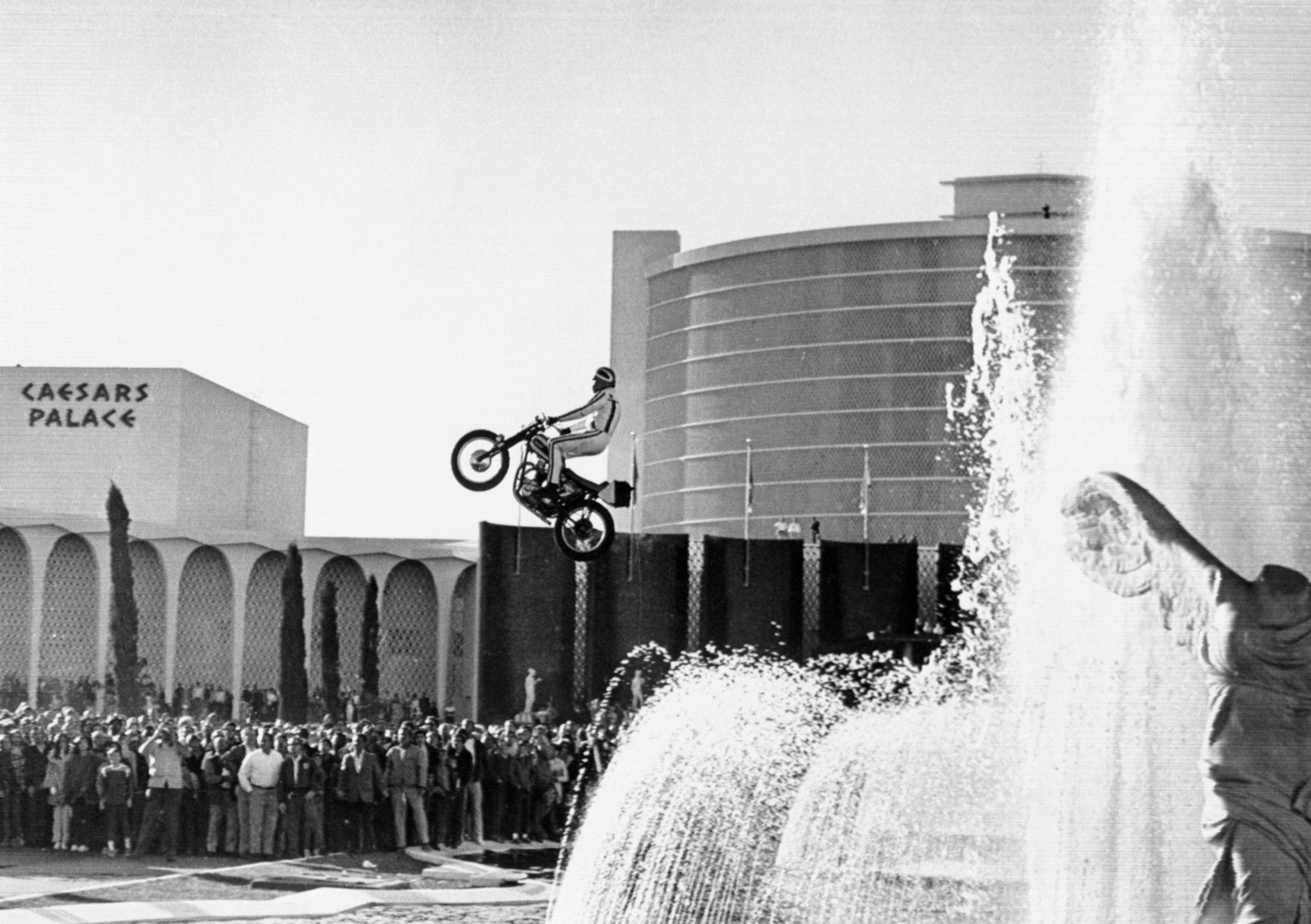
Knievel had the entire jump filmed by actor John Derek and Derek’s then-wife, actress Linda Evans. Evans’ gruesome reel, shot from beyond the landing ramp as Knievel spilled, garnered global playback. “Nobody wants to see me die,” Knievel used to say, “but they don’t want to miss it if I do.” For a man who spoke in headlines and hyperbole, this was an unexaggerated truth. It was only in 1967, when he smashed at Caesars, that people began paying attention to the huckster from Butte.
Knievel vaulted over his motorcycle’s handlebars on to late-night talk shows, and the well-spoken, cowboy-handsome fabulist captivated Technicolor audiences with ease. It was on The Dick Cavett Show where Knievel, seated in a New York soundstage, jazz cat Dizzy Gillespie to his right, joked, “I think the thing that upset me most at Caesars Palace was I bounced into the Dunes parking lot and they never paid me for making an appearance.”
All the right people took notice of the burgeoning star, including actor George Hamilton. The debonair dreamboat, known for mushy roles in By Love Possessed and Light in the Piazza, was working on a story about a rodeo rider turned motorcycle stuntman. The story, however, pivoted when the actor learned of Knievel and saw him as a more compelling real-life protagonist. Hamilton commissioned a script from John Milius, a young screenwriter from Missouri who in that same decade went on to write epics such as Jeremiah Johnson and Apocalypse Now. Milius doubled-down on Knievel’s bravado and further embellished the tales from Butte. (See Knievel busting through sorority house doors and riding up the staircase to kidnap his future wife.)

For the film’s climax, Knievel was to fling his ethyl-chugging XR-750 Harley-Davidson 129 feet over 18 Dodge Colts and one Dodge van lined up inside California’s Ontario Motor Speedway. At this point in his career, he wasn’t yet the main attraction—many of the 80,000 fans packing the grandstands of the newly built $25 million racing palace east of Los Angeles had come for a NASCAR race. No matter. His high-flying act and subsequent movie starring Hamilton as Knievel would launch the real stuntman from opener to main attraction.
The Ontario jump was a smooth spectacle. Only years later, in the biography by Leigh Montville titled Evel, did we learn of the calamity that day. According to an interview with Hamilton, who spent time in the stuntman’s trailer prior to the jump, Knievel was drunk off Wild Turkey and his hand was broken from a practice accident the day before. Worried, Hamilton asked him, “How will you jump with a broken hand?” Knievel replied: “I’ll tape it to the handlebars. It’s logic, George. If your hand is broken, you tape it on.”
We also learn that the weather conditions were better than usual. California’s Santa Ana winds, known to blow over 18-wheelers on the highway adjacent to the speedway, were calm. It was those forceful gusts that blew stunt cyclist Debbie Lawler off course while she attempted a similar jump at Ontario in 1974.
Hindsight is 20/20, though, and in a split second, Knievel’s 300-pound Harley floated down to the landing ramp. Knievel rode away, A.J. Foyt won the race, and America rejoiced. Hamilton’s movie, Evel Knievel, premiered later that June, 50 years ago this summer. Perhaps the film was too goofy, or playboy Hamilton wasn’t rugged enough. It put up decent box-office numbers, but critics were lukewarm. “The life of Evel Knievel contains the same seeds of self-doom as Dostoevsky characters,” said Roger Ebert. “That’s what I miss in the current George Hamilton movie version.” Two stars.

Notwithstanding the lack of cinematic clout, Hamilton’s 1971 Knievel biopic was responsible for one life-altering effect. Knievel was no longer a stuntman, he was a silver-screen superhero, and, as Montville, Knievel’s biographer, put it, “the made-up story, added to his own story, pushed his exploits further into the main stage spotlight that he always craved.” Producers even spliced home-video footage into the movie. By the time the audience left the theaters, they couldn’t parse out truth from Hollywood. The movie, projected 40 feet tall across every drive-in screen nationwide, cast Knievel as an American icon, and now everyone knew his name. What the world didn’t know was that he was just getting started.
A year later, miles from Hollywood, in a nondescript factory on the corner of Jamaica Avenue and 184th Place, in Queens, New York, assembly lines were producing miniature versions of the stuntman. Despite the drab digs, the Ideal Toy Company, famous for its Shirley Temple dolls, was already valued at over $71 million. Looking for more, it brokered a deal to produce an Evel Knievel action figure (Knievel receiving 10 percent of the cut). The doll sold well, but it was the Evel Knievel Stunt Cycle—a 1973 release that put a plastic Evel on a small windup motorcycle that raced off—that was a midair somersaulting license to print money. It was the industry’s top-selling toy in back-to-back Christmases (indeed, you can buy a rereleased version today on Amazon). The daredevil had reached an unthinkable level of stardom, and like the Greek gods of yore whose images were enshrined in marble statuary, Knievel was immortalized in red, white, and blue plastic. Television and movie stars had their own lunchboxes—only superheroes, G.I. Joe, and Knievel had their own action figures.
All told, Knievel netted an estimated $10 million from his toy deal. By 1973, the merchandising fly-wheel was spinning faster than ever: board games, playing cards, bicycles, pinball machines. He was flush with cash and spent as such. He bought yachts, leased planes, and commissioned coachbuilt Cadillacs and a $91,000 semitruck to haul his bikes around. He arrived at events in police-escorted cavalcades. (See Knievel in a pre-jump parade, in Texas, with Dallas Cowboys quarterback Don Meredith riding shotgun in the stuntman’s Ferrari 365 GTS/4 Daytona. Goodbye, modesty—not that there ever was any). Gone, too, were the Nortons, Triumphs, and American Eagles. Knievel exclusively rode Harley-Davidsons, and the firm’s iconic red, white, and blue “1” logo was painted and stitched everywhere. His outfit swelled to match his swagger—rings, chains, furs, massive collars and French cuffs. The cape grew longer, the “EK” belt buckle larger, and his cane became a diamond-encrusted gold scepter; it was metamorphosis into a superfly sovereign.

And his subjects roared. Despite the lavish effects, Knievel preserved his plain-spoken, working-man image. He talked about morals and being “true to your word,” and he wore Old Glory on his back. The public bought in, might have even elected him president in a different era. But this was the era of the 55-mph sign, of new rules and regulations and oil crises and inflation and Watergate. The fences were going up everywhere, yet this stuntman rode from the shadows of the stadium tunnels into the spotlight on his chrome-tipped Harley and launched over everything like Captain America, a red, white, and blue middle finger to the establishment. He flew—the corrupt elites, the nannies, and the naysayers, they took the damn bridge.
Knievel was also literally fighting regulations. Since the late 1960s, he had been haggling with the U.S. government over a plan to jump the Grand Canyon on a motorcycle. Negotiations dragged on for years. As the Hollywood trade rag Variety put it, the two sides had “not yet decided who collects should the flight not prove horizontal.” They never agreed, and the talks subsided. Instead, Knievel—now a millionaire—purchased his own gorge, leasing 300 acres of the Snake River Canyon in Twin Falls, Idaho, for $35,000. Again, screw the system.
As Knievel sorted the jump location, a team of builders, led by engineers Doug Malewicki and Robert Truax, developed a missile-shaped steam-powered two-wheeler prototype called the Skycycle X-1. Steam power was chosen for its simplicity. Behind the cockpit, 77 gallons of water would be heated to 740 degrees, and the resulting steam buildup would be released via a rear-mounted nozzle, propelling the craft to an anticipated 350 mph. This 13-foot-long water rocket would take off from an almost-vertical 108-foot-long metal launching track and carve a steep parabola over the 600-foot-deep canyon. Knievel would deploy a parachute from the cockpit to land on the other side. Or, at least, that was the plan.
By spring 1974, a fall date had been set for the Snake River Canyon spectacle. A pilotless X-1 was launched into the canyon to test the ramp, and Truax was hard at work on the X-2, the rocket that would carry Knievel across the great divide. To the dismay of those investing in the launch, Knievel was flying his Harley more than ever. He completed four massive jumps in various corners of the U.S., despite the fact an injury could delay, or outright cancel, the rapidly approaching pay-per-view event at Twin Falls. Also, America had found other daredevils—or “phonies,” as Knievel labeled them. Rival stunt cyclists came roaring out of the gates with Knievel in their crosshairs. Maybe Knievel felt the need to defend his crown. Regardless, he couldn’t shy away from the spotlight, an intense beam that was burning hotter with each appearance.

As the Skycycle X-2 neared completion, Idaho law required it to be registered as an aircraft. Knievel’s pre-jump speeches developed a bombast and started to sound more and more like screenwriter Milius’s handiwork. Prior to a jump at Portland’s Memorial Coliseum, Knievel addressed the crowd: “It’s my canyon. They cannot take that away from me. And the only way they’re going to stop me from jumping is with an anti-aircraft gun. They’re going to have to shoot me out of the air!” The militant, over-the-top Hollywood lines had crept into the real Knievel vernacular. He had become his own caricature.
By the time Knievel was hoisted into the vertically positioned rocket on September 8, 1974, the scene on that cliff’s edge resembled a debauched Woodstock. A semicircle of humanity, miles wide, drawn out from the 50-foot-high dirt launchpad, was densely packed with dehydrated fanatics, fed-up reporters, hippies, biker gangs, and anyone else who could pay $25 for admission to the party. Sideshow acts included a blindfolded motorcycle-riding psychic, a woman suspended by her hair from a helicopter, and a high-wire act near the canyon’s edge by Karl Wallenda of the Famous Flying Wallendas.
Since the pre-jump theatrics and the jump itself were largely put on for customers watching in theaters on closed-circuit, the atmosphere at the launch site was unstable. It was “a circumstance that further agitated the spectators who pressed together in the sunbaked horse pasture drinking beer impatiently,” as a reporter for The Spokesman-Review of Washington noted. “By noon a noticeable number of young men, dirt-streaked and perspiring, staggered over the dusty ground, wearing the same surly look they had arrived with in Idaho.” Amenities were lacking and tension was thick. One newspaper reported that “bored and restless” campers stole 4000 cases of beer from concession trailers while others set fire to portable toilets. Over 30,000 pushed and shoved their way toward the canyon’s mouth in anticipation of Knievel’s launch.

At 3:36 p.m., with an explosion of white steam, Knievel was thrown back into the seat of the Skycycle X-2 as it cleared the launch track. In a split second, missile and man were soaring high above the canyon. The only snag was quite literal; upon takeoff, the parachute prematurely evacuated the fuselage. Knievel was a passenger in a rocket-powered kite. As the X-2 crested its parabola, a 15-mph wind pushed the vessel back toward the launch ramp. The crowd gasped as Knievel and rocket dropped like Wile E. Coyote in slow motion. After bouncing twice on the rocks and landing in a foot of water on the canyon floor, he was able to get out. In a mixture of relief and exhaustion, he provided few words to reporters: “I sat in it and gave it my best. I don’t know what to tell you.” Knievel may have not cleared the canyon, but he did clear an estimated $20 million from the escapade, and despite the failure, he was riding an all-time publicity high.
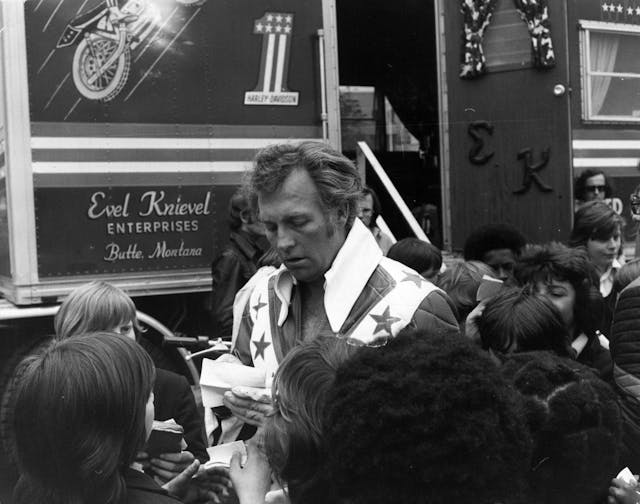
Just a year after Snake River, Knievel took his North American dominance across the pond in what would be labeled by many as the beginning of the end. By the time Knievel was prepped to vault 13 London buses in front of the 80,000 people packing Wembley Stadium, he seemed dejected, forlorn, tired. ABC broadcaster and close friend Frank Gifford spoke to him before the jump. “He was a little wacko,” the late broadcaster recalled in Montville’s biography. “I kind of admired him.” According to Gifford, Knievel confessed to his TV friend that he couldn’t make it over the London buses.

Gifford urged him to cancel the event. Knievel refused to back down. “Well, I may not be as good as I always was, but I’m as good once as I ever was,” he told a worried Gifford on ABC’s Wide World of Sports prior to suiting up, like a cowboy who had already seen his best days. Knievel landed short and splattered onto Wembley’s paved floor. Gifford thought he had witnessed his friend’s death and rushed over to the motionless pile of bloody flesh and torn leather. To Gifford’s surprise, Knievel was trying to speak. Prepared to hear the stuntman’s dying words, Gifford bent down to Knievel’s battered face.
“Frank …” said Knievel.
“Yes, Evel,” replied Gifford.
“Get that broad out of my room.”
Despite a broken back, Knievel refused the stretcher and instead asked to be propped up and carried to the top of the landing ramp, where he addressed the stunned audience. “I’ve got to tell you that you are the last people in the world to see me jump because I’ll never jump again. I’m finished.” Knievel was finally retiring.
His retirement only lasted the plane ride home. Perhaps he didn’t want to end his career on a crash. Perhaps he had obligations to Harley-Davidson. Or perhaps, in those silent hours above the Atlantic, worry crept in about what he might do, might become, after jumping was no longer an option. One reporter wrote, “Of course, someone waved a few million under his nose to bring him back to the real world.” Regardless of his motives, the minute he touched down at JFK, he announced he would jump later that fall.
In the four years since the movie debuted, since he was shot into the celebrity stratosphere, Knievel had been caught in a whirlwind of victories, defeats, alcohol, prostitutes, chronic jet lag, incessant media coverage, and hospital beds. Those four years had aged the man tremendously. Grays were starting to poke out of his slicked-back sandy quaff, and the 36-year-old limped like a reanimated corpse.
He would attempt a record jump at Kings Island, an amusement park in southeast Ohio. Up and over 14 Greyhound buses, one more than the jump that nearly killed him in England.
In what was the most-watched episode of ABC’s Wide World of Sports, Knievel soared over the Greyhound buses at Kings Island on October 25, 1975. Nielsen said that just over half of all U.S. homes tuned in to watch Knievel clear 163 feet (a personal best and a record that stood for 24 years). Not even the famed 1976 title fight between Muhammad Ali and Joe Frazier could dethrone King Knievel’s ratings from that day. The force of the landing snapped the frame of Knievel’s XR-750 in half, but he was able to ride back to the landing ramp for his interview, where he told old pal Frank, “I have jumped far enough.”

Knievel’s jumping career didn’t end like the 1971 biopic, clearing the ramp and riding off into the sunset as the camera pans skyward. Reality was less graceful. If Kings Island was the apex, the daredevil still had to land. And he landed hard. In 1977, Knievel was still riding the fame wave and produced the film Viva Knievel!, where the untrained actor played himself battling a Mexican drug cartel. It tanked. The same year, CBS also aired Evel Knievel’s Death Defiers. Critics were ruthless. A reporter from a small Kansas newspaper, The Manhattan Mercury, matched many sentiments when he wrote: “In a desperate and irresponsible bid for ratings, CBS is permitting the ego-ridden exhibitionist Evel Knievel to appear and wrangle top billing by gunning his motorcycle over a huge salt-water pool of man-eating sharks.” He crashed in practice, fracturing his left arm and collarbone, and never jumped the sharks.
As if 1977 couldn’t get any worse, Knievel found himself on the wrong side of a judge’s gavel in November. In an act of what Superior Court Judge Edward Rafeedie called “frontier justice,” Knievel infamously beat his former press agent, Sheldon Saltman, with a baseball bat after reading Saltman’s tell-all book, Evel Knievel on Tour. The book provided a look behind the showman’s curtain and—according to Knievel—portrayed him as a villain. Knievel was ordered to spend six months at the Wayside Honor Rancho correctional facility near Los Angeles.
Explaining why checks he sent in 1977 to fund an Indy 500 team had bounced, Knievel wrote from prison: “I have not lost the race. I’m in the pits now getting fuel and changing tires, but the boost is going up and when I come back, they better get their ass out of the way.” He never did come back in the way he promised, performing small jumps here and there in the twilight of his career, eventually surrendering the Knievel spotlight to his daredevil motorcycle-riding son, Robbie.
Knievel succumbed to pulmonary disease on November 30, 2007. This was not the fantastic ending he, or even Milius’s screenplay, envisioned. The stuntman who once seemed immortal was buried in Butte at the Mountain View Cemetery, his grave marked by a tombstone he commissioned for his Snake River jump. The engraving read: “A mile-long leap of the Snake River Canyon from this point on September 8, 1974 employing a unique ‘Sky Cycle.’” While we don’t know where he went in his journey to the great beyond, it’s safe to assume he didn’t drive across the damn bridge.
Evel’s stunts invited many contemporaries, including Debbie Lawler, who broke Knievel’s indoor jumping record and inspired an action figure of her own. Read Cameron Neveu’s story on Lawler here.

